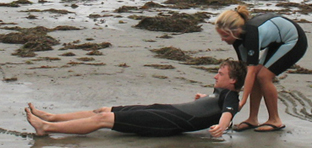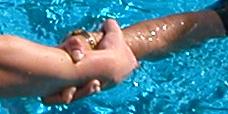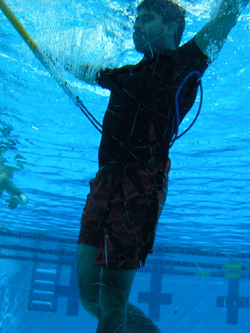 A beach drag method of removal from water is used in shallow water on a sloping shore or beach, or a zero depth exit at a pool. It works well with a heavy or unconscious victim. Do not use a beach drag if you suspect the victim has a head, neck or back injury.
A beach drag method of removal from water is used in shallow water on a sloping shore or beach, or a zero depth exit at a pool. It works well with a heavy or unconscious victim. Do not use a beach drag if you suspect the victim has a head, neck or back injury.
– – – – – – – – – – – – – – – – – – – – – – – – – – – – – – – – – – – – – – – – – –
The Beach Drag is described the 2024 American Red Cross Lifeguarding Manual on page 178:
“ NOTE: Do not use this technique if you suspect the victim has a head, neck or spinal injury, the person is breathing and a backboard is on the way.
1. Stand behind the person and grasp them under the armpits, supporting the victim’s head as much as possible with your forearms.
If you are using a rescue tube, let it trail behind, being careful not to trip on the tube or line.
If two rescuers are available, each rescuer grasps the person under the armpit and supports the person’s head.
2. Walk backward and drag the person to the shore or deck. Use your legs, not your back.
3. When you are clear of the water, gently lower the person to the ground, ensuring that there is adequate clear space to provide care.
4. Assess the person’s condition and provide appropriate care.”
– – – – – – – – – – – – – – – – – – – – – – – – – – – – – – – – – – – – – – – – – –
The Beach Drag was described the 2017 American Red Cross Lifeguarding Manual on page 190:
- “Stand behind the victim and grasp him or her under the armpits, supporting the victim’s head as much as possible with the forearms. Let the rescue tube trail behind, being careful not to trip on the tube or line. If another lifeguard is available to assist, each of you should grasp the victim under the armpit and support the head.
- Walk backward and drag the victim to the shore. Use your legs, not your back.
- Remove the victim completely from the water, then assess the victim and provide appropriate care”
– – – – – – – – – – – – – – – – – – – – – – – – – – – – – – – – – – – – – – – – – –
The International Life Saving Federation (ILSF) has some additional notes
on why lifeguards do it this way.
“For centuries, people have believed that water should be drained from the lungs of a drowning victim as an essential part of the effort to revive them. In the 18th century, this was the main reason given for placing the victim in a head-down position (HD) on sloping beaches. This position was subsequently adopted by many lifesavers throughout the world.”
But all recent research shows that trying to drain water is not necessary, and a waste of time, as massive amounts of water are usually not aspirated “Massive aspiration of water is seldom observed in humans who arrive at the hospital alive… Approximately 85% of people who die in the water and a much larger number who are resuscitated aspirate 22ml/kg or less and only about 15% of those who die aspirate an amount greater than this.”
… A head-down position is more likely to cause vomiting than a “head in the same level as the trunk – HT position”… head-down “increases the likelihood of regurgitation of gastric content (vomit). Presence of vomit in the airway can result in aspiration of vomit by the victim. It obstructs resuscitation efforts. The presence of vomit can be discouraging to rescuers, particularly those using mouth-to-mouth resuscitation”
And the ILSF reminds us to move the victim far enough up the beach to be away from moving waves.
If the first rescuer needs to do CPR they should be in a position with their back to the water. If they move to the uphill side of the victim they are more likely to fall over the victim as they do compressions.
You can read more at the International Life Saving Federation Medical Policy Statement Positioning of Patients on a Sloping Beach:
https://www.ilsf.org/lifesaving/position-statements/
and click on positioning a patient on a sloping beach
At a steep beach it is often policy for a rescuer of an unconscious victim to do a partial u-turn and place the victim parallel to the shore line, rather than pulling them directly up onto the shore.
If we don’t, the victim’s head could be quite higher than their feet and any CPR you would do would not work very well at getting oxygen to the brain when working against gravity.
A 2012 Red Cross waterfront lifeguard skills video shows it happening this way but does not talk about it or why to do it.
– – – – – – – – – – – – – – – – – – – – – – – – – – – – – – – – – – – – – – – – – –
(Note to on-line users not in my classes: this is a study sheet. It is not complete instruction in doing rescues or the topic named in the webpage title.)
Practice should be done under the supervision of an instructor trained in how to do the skill.
The author of this webpage, (written as a homework reading assignment for my students), does not give any warranty, expressed or implied, nor assume any legal liability or responsibility for the accuracy, completeness, or usefulness of any information, product, or process included in this website or at websites linked to or from it. Users of information from this website assume all liability arising from such use.
– – – – – – – – – – – – – – – – – – – – – – – – – – – – – – – – – – –
See also:
details about How To Call 911
including
what to do if you dial 911 by mistake
advice for using a cell phone to call 911
situations to NOT call 911
and the answer to the question; “Why Shouldn’t I Just Drive the Patient Myself” instead of getting an ambulance
How to rescue a drowning victim using a reaching assist or a shepherd’s crook


Butterflies can be seen sometimes trying to dip down toward a swimming pool surface and sometimes can’t fly away. We suggest that if you want to rescue one of them struggling at the surface you do not try to catch it with your fingers, but instead dip your arm down in the water under it, then lift your arm to the side of the pool and wait for it to flutter its wings and dry out enough to fly off:
![]()
The butterfly above appears to be a California Sister (Adelpha californica).
and perhaps of interest:
There is no guarantee of rescue in a National Park.
How to call 911 includes:
what to do if you dial 911 by mistake
advice for using a cell phone to call 911
situations to NOT call 911
and the answer to the question; “Why Shouldn’t I Just Drive the Patient Myself” instead of getting an ambulance